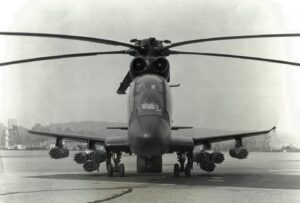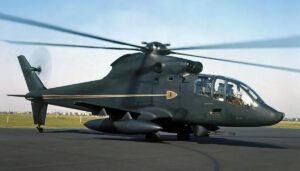The Sikorsky S-67 Blackhawk was a privately funded, prototype attack helicopter developed in 1970 using Sikorsky Aircraft’s research and development funds. As a tandem, two-seat aircraft built around the dynamic drive and rotor systems of the Sikorsky S-61, it was intended to function as an attack helicopter or to transport up to eight soldiers into battle.
Here’s What You Need to Remember: The S-67 Blackhawk wasn’t just fast, it also boasted significant firepower. On attack missions, the helicopter could carry over 7,000 pounds of weapons and ammunition—including a turret-mounted 7.62 machine gun, 20 and 30mm cannons, 40mm grenade launchers, and even wing-mounted rockets or TOW missile pods for engaging heavy armor or tanks.

Sikorsky’s H-60 series of Black Hawk helicopters are renowned for their battlefield prowess, but almost a decade before the first UH-60 entered service, Sikorsky had a different Blackhawk in mind: the S-67 attack helicopter.
A year before the United States entered the Vietnam War, the U.S. Army requested proposals for the Advanced Aerial Fire Support System (AAFSS) program, aimed at designing a helicopter specifically for armed military operations. By February 1965, the Army awarded contracts to both Lockheed and Sikorsky for further development on their respective designs, with Sikorsky submitting the S-66 and Lockheed offering their CL-840 Cheyenne. Ultimately, Lockheed’s proposal won, securing a development contract for 10 combat helicopters, only for the program to be canceled in 1969 due to Lockheed’s failure to address numerous technical issues within Cheyenne.

After Cheyenne’s failure, the Army was left operating their backup plan: the simpler, less advanced, and less expensive Bell AH-1G Cobra, which went on to gain fame in the Army and Marine Corps for decades. Meanwhile, Sikorsky, the company whose namesake invented the first practical helicopter, continued working on their attack helicopter designs.
An attack helicopter without a defense contract

Recognizing that the United States was quickly understanding the value of capable military helicopters like the UH-1 Iroquois (better known today as the “Huey”) in Vietnam, Sikorsky began work on another attack helicopter design. This new rotorcraft would incorporate lessons learned from the S-66 as well as insights from Cheyenne’s failure. By mid-1969, Sikorsky initiated development on their new high-speed helicopter gunship: the S-67 Blackhawk.
Without defense contract funding, United Aircraft Corporation decided to fully fund the S-67 program, eager to position themselves well for the next military contract seeking a capable helicopter gunship. By January 1970, Sikorsky’s executive vice president, John A. McKenna, was appointed to oversee the program, which called for a helicopter weighing between 18,000 and 20,000 pounds and capable of reaching speeds as high as 200 knots (or around 230 miles per hour) in a shallow dive.

McKenna took charge, accelerating development by combining new design elements with the old, creating a new helicopter that utilized proven components and methodologies.
“The S-67 is a combination of proven components and new design concepts,” a Sikorsky fact sheet stated.
“The result is a new helicopter weapons system at greatly reduced cost and technical risk; high performance, ease of maintenance, and early availability.” They built the S-67 Blackhawk in just seven months
McKenna’s approach paid off when his team produced their first working prototype just seven months later. The new S-67 Blackhawk featured swept wings and a large cambered vertical fin for stability. In fact, the S